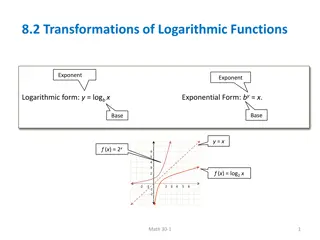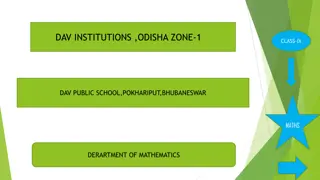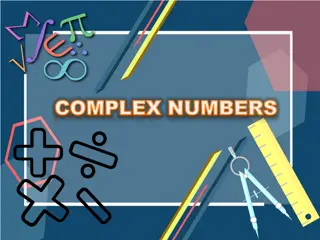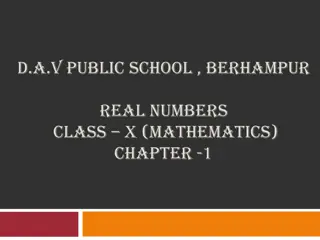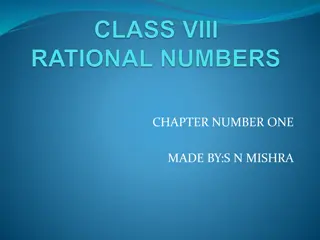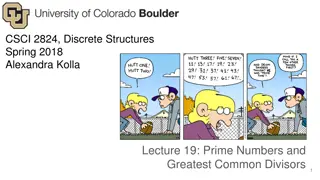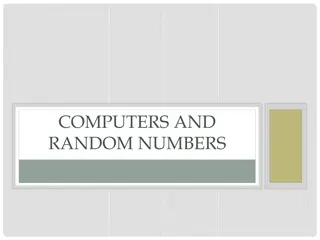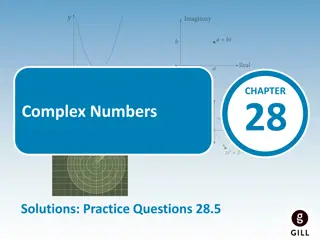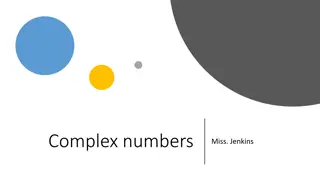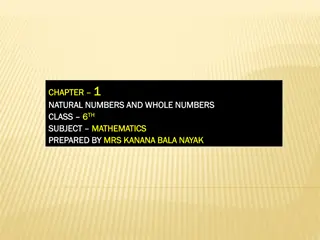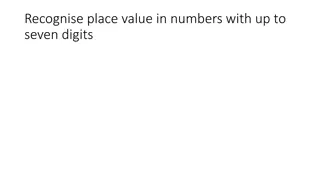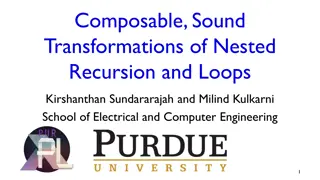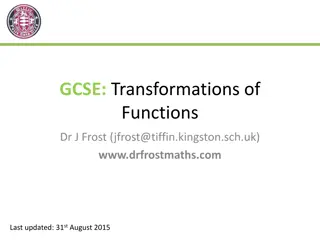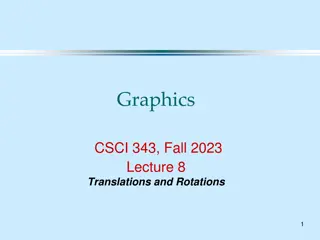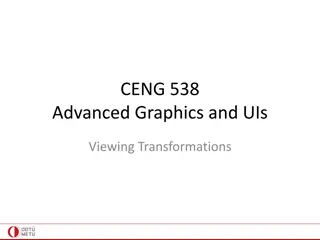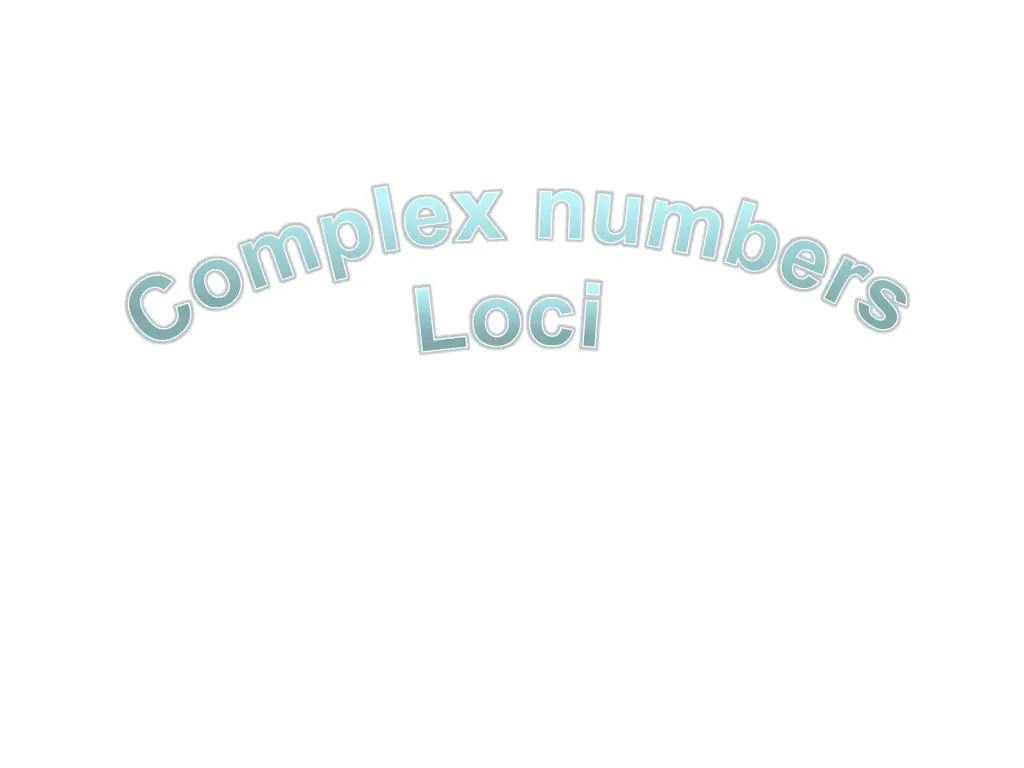
Understanding Complex Numbers and Loci Transformations
Explore the effects of various mathematical transformations on complex numbers and loci in the Argand diagram. Learn how to represent regions of points, understand different types of graph transformations, and analyze the impacts of specific transformations on loci expressions. Gain insights into stretches, circles, and other geometric changes using complex plane concepts.
Uploaded on | 2 Views
Download Presentation

Please find below an Image/Link to download the presentation.
The content on the website is provided AS IS for your information and personal use only. It may not be sold, licensed, or shared on other websites without obtaining consent from the author. If you encounter any issues during the download, it is possible that the publisher has removed the file from their server.
You are allowed to download the files provided on this website for personal or commercial use, subject to the condition that they are used lawfully. All files are the property of their respective owners.
The content on the website is provided AS IS for your information and personal use only. It may not be sold, licensed, or shared on other websites without obtaining consent from the author.
E N D
Presentation Transcript
Complex numbers Loci
Complex numbers: Loci in the Argand diagram KUS objectives BAT Use complex numbers to represent a region of points on an Argand diagram Starter:
Reminder: 6 types of transformations of graphs Sketch or describe the six types of transformation of ? = ?(?) represented by: ?(? + ?) ? ? + ? ?(?) ??(?) ?(??) ?( ?)
WB21what is the effect of the transformation ? =? 2 on the function ? = ?2 ? In GCSE you learnt that 4 ?(?) was a vertical stretch x 4 Taking a slightly different approach to this transformation m = ( 2m = 2 x x m Rearranging: y = 2 4m y 2 )2 = 2 y = 4m Substituting this: y Graphically m = y = 2 x x 2 x m This method can be used to understand transformations in the complex plane
WB22 what is the effect of the transformation w = ?? on the locus given by ? = ? Where k is real and positive make z the subject w = ?? ? =? substitute into the locus expression locus of z ? ? ? = ? So ? = locus of w Rearrange to ? ?= ? So ? = ? ? = ?? So the transformation is a stretch factor k
WB23 what is the effect of the transformation w = ? + ?1on the locus given by ? = ? Where k is real and positive = + = + z = w z 1 z w z 1 z a Make z the subject = locus of w z w 1 z Substitute into locus expression & rearrange to a familiar locus 1 z locus of z z = a = w z a 1 So ? ?1 = ? is a circle centre ?1 radius a
WB24 what is the effect of the transformation w = ?? + ?1on the locus given by ? = ? Where k is real and positive = + = + z = w kz 1 z w kz 1 z a Make z the subject w z locus of w = 1 z Substitute into locus expression & rearrange to a familiar locus k 1 z locus of z z = a w z = 1 a = w z ka 1 k So ? ?1 = ?? is a circle centre ?1 radius ka
Summary so far w = z + z1 where z1 = a + ib represents a translation vector ? ? w = kz represents an enlargement scale factor k centre (0,0) w = kz + z1 where z1 = a + ib represents an enlargement scale factor k centre (0,0), followed by a translation vector ? ? Other transformations are less obvious to spot, but can be interpreted using the same method as before Make z the subject Substitute into locus expression & rearrange to a familiar locus Typically this requires introducing ? = ? + ?? and some manipulation
WB25 a) Show that the transformation ? =?1 z-plane onto ? = ? 1 in the w-plane The region ? 1 1 in the z-plane is mapped onto the region T in the w-plane b) Shade the region T on an argand diagram ? maps ? 1 = 1 in the a) Make z the subject 1 = w 1 w = 1 1 1 = 1 z Sub in 1 w ( 1 1 z is perpendicular bisector between (0,0) and (1,0) = w ) w 1 w z = wz 1 Making common denominator = 1 1 = ) 1 w 1 1 1 = wz z ( z z w = 1 Simplifying 1 w 1 2 a a= = w z = 1 1 w b b 1 w w 1 w so is left of this line Cross- multiplying = = 1 w w = 1 a b b a w w
WB26 The transformation T from the z-plane to the w-plane is given by ? =3?2 Show that the image, under T, of the circle with equation ?2+ ?2= 4 in the z-plane is a circle C in the w-plane. State the centre and radius of C. ?+1 Circle ?2+ ?2= 4 is represented by ? = 2 + + ) ) = + ( 2 2 3 ) iv + ) 3 u ( ( iv u iv 3 2 z = w + + 1 1 z + + = 2 2 3 u iv u ( ( ) = 3 ( 2 w z z + 2 2 + + = + 2 2 2 4 u v u ( u v ) + = + 2 w 3 3 w z w ) 2 + + + = + 2 2 2 2 4 4 4 6 9 u u v u v = z w + + = 2 2 3 28 3 32 + 0 = u u v + + 2= w w = 2 z 2 2 2 3 0 28 32 u ( ( u ) ) v 3 3 v + = 2 2 3 w w 2 + + = + = 2 0 196 32 u 14 3 9 3 2 2 100 u v 14 Use ? = ? + ?? 3 9 14 3,0 radius 10 Circle centre 3
WB27 A transformation T of the z-plane to the w-plane is given by ? =??2 Show that as z lies on the real axis in the z-plane, then w lies on the line L in the w- plane. Sketch L on an Argand diagram 1 ? So ? = ? + 0? as z lies on the real axis + + 2 u iv = z 2 iz + v + ) u ( ( i )( + ) 1 iv + i =1 w w w w w ( u ) + + w = z + + 2 i 1 u iv u i = z ( ) ( ) 1 + ) 2 ) 1 + 1 + = 1 2 z iz iz + ( i + ( u v u v ( ) ( ) = iz z 2 wz w + 2 wz 2 2 + + u + + + + 2 1 u i u v iuv v v = z = = + ( )2 2 1 v ) ( )( + ) ( ) ( ( 1 u + + 2 + 2 + v + 2 2 1 2 uv u v u u v v + = i z ( ) v ) + 2 + + 1 v u z + i w v ( )( + 2 ) u + + 2 1 uv As z can be anywhere on the real axis and so its locus is z = x + 0i, we need to manipulate our expression into this form, starting by using the complex conjugate in order to separate real and imaginary parts. We can then equate them with the known expression for z = x + 0i u v Use ? = ? + ?? = 0 ( + ) v locus of w 2 + ( u uv 2 1 )( v u ) 0 1 = 2 v + uv 2 1 1 = 2 0 = uv u 1 v u 2
WB28a The transformation T from the z-plane to the w-plane is given by ? =?+? a) The transformation T maps the points on the line with equation ? = ? in the z- plane to points on the line L in the w-plane. Find an equation of L b) Show that the image, under T, of the line with equation ? + ? + 1 = 0 in the z- plane is a circle C in the w-plane. State the centre and radius of C. c) Sketch l and C on the same Argand diagram ? ( ( ) ) iv 1 + z i 1 i u iv = = w z ( ) iv + 1 ) ) 1 z wz u u = + ( z i + 1 i u v = z ( 2 = = i + 2 wz ( w z z i u v ) i 1 2 1 u v + = i z ( ) ( ) 2 + 2 + 2 1 1 u v u v = z 1 w v 1 + v u = locus of w ( ) ( ) 2 2 + 2 2 1 1 u v u v = + w u iv Use u 1 i 1 = 1 v u = z + 1 u iv
WB28bc The transformation T from the z-plane to the w-plane is given by ? =?+? a) The transformation T maps the points on the line with equation ? = ? in the z- plane to points on the line L in the w-plane. Find an equation of L b) Show that the image, under T, of the line with equation ? + ? + 1 = 0 in the z- plane is a circle C in the w-plane. State the centre and radius of C. c) Sketch l and C on the same Argand diagram ? 2 1 b) If z lies on ? + ? + 1 = 0 u v + = i z ( ) ( ) 1 + v u 2 + 2 + 2 1 1 u v u v + + = 1 0 ( ) ( ) 2 2 + 2 ) 1 2 v ) 1 2 1 ( u 1 u v u v v ) ) ( 1 ( + 2 + + + 2 1 u v u v = 0 ( 2 + L 2 + + = 2 1 0 v u u v C u + + + + = 2 2 1 + ) ) 2 = 1 0 v u u u v 1 + 2 2 0 u ( ( u v v ( ) 1 2 2 + + ) = 0 Circle centre radius 1 u v 1 1 1 1 2 4 ( 2 4 1 2, 1 2 2 2 + + = u v 1 1 1 2 2 2 2
WB29The transformation T from the z-plane to the w-plane is defined by ? =2(1+?) ?+2 straight line in the w-plane, and show this in an Argand diagram Show that the locus of P in the z-plane is mapped to part of a 2 z i P = arg P is the locus of z such that , found previously + 2 2 z Make z the subject 2 z i = ( z ) arg Sub in + 2 1 + i + 2 2 z = w 2 ( ) + 2 1 2 i w 2 i ( ) ( ( ) i ) i + = + = + arg w 2 2 1 w z ( ) + + 2 1 2 i w 2 2 w + = 2 2 ) i ) w 1 wz w ( 1 ( ) + 2 1 2 w 2 i w iw = arg ( ) = + 2 ( 1 2 wz w + + 2 1 2 2 i w w 2 w 1 + 2 2 i w ( ) 2 ( ( ) ) + + = 2 1 2 i 1 i w i z = arg ( ) + 1 2 Part of a line suggests keep in arg( ) form is a half-line starting from w at an angle of 90o to (1,0) ( ) = 1 arg w 2
WB30 June 11 Q5 pure evil The point P represents the complex number z on an Argand diagram, where the locus of P as z varies is the circle C with Cartesian equation ?2+ (? 1)2= 4 The locus of P as z varies is the curve C. A transformation T from the z-plane to the w-plane is given by ? = ?+? 3+?? , ? 3? The point Q is mapped by T onto the point R. Given that R lies on the real axis, (c) show that Q lies on C. Most questions ask you to transform z onto w, this question does the opposite Hence you want to consider an expression for w in terms of z = x + iy ( y ) ( ( ) ) ix + + + + 1 3 x + = iy i x 3 i y y ix = = = + w z x iy ( 0 ) ( )( y ( y ( y ) ix + ) y 2 y ) 1 ) 1 + 3 w 3 0 i x iy ( x y + + + + 2= = 3 4 1 3 Im y x 3 1 R on x-axis 2 2 0 = 2 2 0 x x 2 = 2
The perfect formula? i z = When and = ie = z = 1 re r in the exponential form this gives Im = 1+ 0 z i But if ie = 1 This gives Re ( ) 1 1, 0 z This single formula brings together key concepts in mathematics integers, negative numbers, pi, exponentials, real and complex numbers! Complex numbers have many applications in Mathematics, science and engineering. What started as an imaginary concept actually turns out to have many real applications such as fluid dynamics, electrical engineering, control systems in mechanical systems, quantum mechanics, relativity and differential equations in areas as far reaching as economics and biology.
KUS objectives BAT Use complex numbers to represent a region of points on an Argand diagram self-assess One thing learned is One thing to improve is


